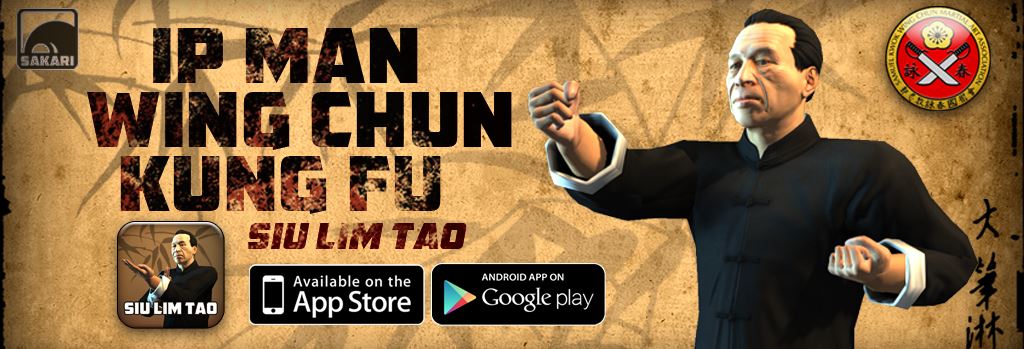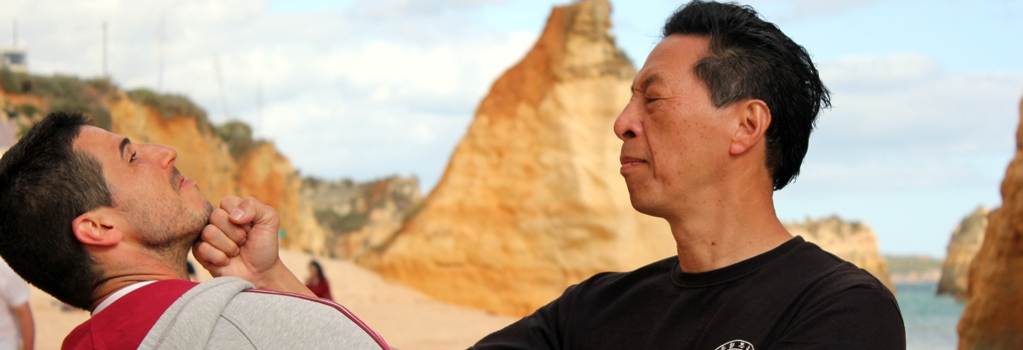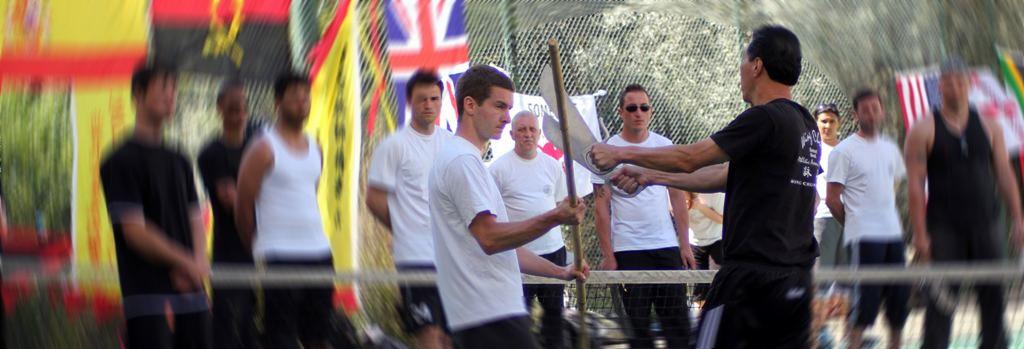Wall Bag Training for Wing Chun
Article by Dan Knight added on 26 Aug 2012. Last updated on 26 Nov 2012.
The wall bag is a great way to practice the various strikes of the Wing Chun system, it can also help to develop power in the last inch of the strike (some times refereed to as inch energy or last second energy). the wall bag can also help practitioners practice striking and simultaneous blocking with turning to further their understanding and performance in Wing Chun. However if wall bag training is not done correctly it can lead to serious and potentially permanent injury.
What type of wall bag?
There are many different types of wall bag. Some have three sections others have only one. Three section wall bags can have each section filled differently; this gives a different feel when striking the different sections. The bottom section of a three section wall bag can be used to train kicking. Most wall bags are made of either leather or canvas but other materials are suitable. Canvas wall bags are often more durable than leather ones especially for kicking however the canvas can cause abrasion on the knuckles when striking, This problem will become very acute if the punches don't land straight. Any sideways or downwards motion at the point of impact will cause serious abrasion to the hands on a canvas bag (and to a lesser extent on a leather bag). A common flaw when beginners are chain punching is to drop the punch before impact if this is done on a wall bag it can cause damage to the hand and it takes a large amount of the power out of a punch. You should choose your wall bag carefully.

This wall bag is a canvas bag offered by an Amazon supplier. It was £19.99, but its now only £8.99. Canvas bags are harder on the skin but much more durable. This bag is not ideal for beginners to use without hand wraps or other protection.
What to fill it with
The next question is what to fill it with. Different fillings will condition your knuckles differently. Rice is generally a good filling to start with. Dried beans like black eyes beans or kidney beans give a slightly harder impact. Sand makes for a dense filling. Very advanced students may wish to use fine gravel or even lead shot. However if you do use gravel or ball bearings or lead shot before you are ready you will not condition your knuckles quickly. Instead you may find your hands crippled for life. Therefore you should pick your wall bag filling carefully. Some people like to put beans in the top section of a three section bag to simulate a harder head strike, and then fill the middle section with rice or sand for a dense body like feel, and anything for the bottom section for kicking. If you're using sand avoid using the orange building sand as the colour may leak through onto your hands and stain the wall behind etc.
Basic wall bag training
Once you have decided on a bag and filling you can begin training on it even if you are a complete beginner, however you must know how to train properly so as to prevent damage that will hinder rather than improve your overall martial arts training. Punches should be done slowly to start with to develop good technique before speed. Basic training involves standing in front of the bag at a distance that lets you hit it comfortably without stretching. The punch should hit the bag before the arm is locked out straight. Striking is done with the bottom three knuckles. Knowing that the bag is fixed to a solid wall, the student should remember that a great deal of the force of the strike will return into their body and so the bag should not be hit with full force regularly especially for beginners. The fist should be thrown relaxed and tension should occur just before impact. Mastering this use of last second energy will dramatically increase the practitioners striking power. Another way to train this is to try hitting the bag hard but only from a couple of inches away.
Training plan
A good training method is to do punches on the bag once ten times (in the form - left punch, right punch, left punch etc) then twice (left then right) repeated ten times. Then sets of three chain punches repeated ten times. The same for sets of four, five and six chain punches. Then the practitioner can perform simultaneous Tan Sao and punch then swap over so the Tan hand punches and the punching hand performs a Tan Sao. This can be done with turning and can be repeated twenty times. The practitioner can then do 20 Biu Sao and punch, then low Gaun Sao and punch, then downward Pak Sao (Kop Sau) and punch. Then the practitioner can finish up with 100 punches. A good tip for counting chain punches is to only count one hand i.e. count fifty punches with your right hand and your left will have done the same amount.
Therefore the basic training scheme looks as follows:
| Technique | Number of repetitions |
|---|---|
| Single punch | 10 |
| Two punches | 10 |
| Chain punching sets of 3 | 10 |
| Chain punching sets of 4 | 10 |
| Chain punching sets of 5 | 10 |
| Chain punching sets of 6 | 10 |
| Tan Sao and punch | 20 |
| Biu Sao and punch | 20 |
| Low Gaun Sao and punch | 20 |
| Downwards Pak Sao and punch | 20 |
| Continuous chain punching | 100 |
Remember to progress...
Once this training scheme becomes too easy increase the number of chain punches, for example, go up to sets of eight or twelve instead of stopping at sets of six. Also the number of repetitions can be increased . Also for an alternate style of training replace every punch with a vertical palm strike. Track your progress and see how quickly you improve but remember to keep your technique good.
Kicking
When kicking the bottom section of a 3 section bag the heel of the foot should be driven straight from the floor into the bag in one fluid motion rather than chambering the kick which uses the two motions of up and then out. Practice kicking off of both legs and also from the leg forwards or backwards when in a stance. Your front leg is trained for a quick kick and your back leg for a slower but more powerful kick.
Palm striking
A palm strike should follow the same principles as the punch. The wrist should be straight and the elbow should not be locked. The strike should always hit true and not be glancing. Also when chain punching or performing chain palm strikes you should try to hit the same spot on the wall bag. Vertical, knife edge and horizontal palms (as seen in Sil Lim Tao) can all be trained.
Ironing out weaknesses
Most people have a strong side. I.e. are dominantly right or left handed. This usually means one hand can hit harder than the other. However in a fight you need to be able to strike well with both hands and cant always pick where you opponent will be and which hand you will have free. This is one reason its important to train your weak hand more to try and balance the difference. Another good reason is to prevent a muscle imbalance in your body. This is where one muscle group is much stronger than the other and is a very common cause of sports injury. One side is too strong for the other side to stop effectively (when performing a Lap Sau for instance). A wall bag is a good way to train your weak arm. Consider finishing every wall bag session with 3 sets of 50 punches from your weakest arm. Do more or less depending on your level of fitness and the difference in the gap between your arms power.
Elbow Strikes
Don't train them on a wall bag, Ever! That's right DO NOT. The reason is because the returning force from an elbow goes straight into the spine via the shoulder. With a punch the bend in the arm will absorb much of the returning force. With an elbow this does not happen. Several keen Wing Chun students have caused themselves permanent and debilitating damage from training this. If you want to train your elbow strikes (which you should) use a focus mitt held by a partner.
Dit Da Jow
Many martial artists will swear by using Dit Da Jow before, during and after conditioning sessions like wall bag training. If your not training too hard this should not be necessary. It can be expensive or hard to get hold of and it will make you smell like an alcoholic (because it is made in spirit alcohol). However it can reduce bruising and is said to help repair damaged bones and increase blood flow amongst other things. If you do use it remember to pick a Jow without heavy metals in. And only use it externally on non broken skin. If you get a cut or graze stop using Dit Da jow.
Calcium and nutrition
If your training hard on a wall bag make sure you get enough calcium in your diet to repair damaged bones. Also make sure you have protein to help repair and strengthen your muscles. For more info see nutrition and Wing Chun. Vitamin D is also needed for calcium absorption.
Injury
If you train properly and don't rush ahead of your ability you will minimise the risk of injury. However you will cut your knuckles at some point if you train hard on a wall bag without gloves or hand wraps. When this happens avoid the temptation to keep training. It may make you feel powerful to hammer the wall bag with you bleeding knuckles like some sort of film star boxer but it will make the graze or cut bigger which will scab over and take longer to heal. If you train on it again before it has completely healed it will open up and slow your training down again. The same is true of bruising or non visible damage. Give yourself time to heal and you will improve quicker.
Good luck with your training
Tags for this article:
Wall BagTrainingDit Da JowChain Punching



